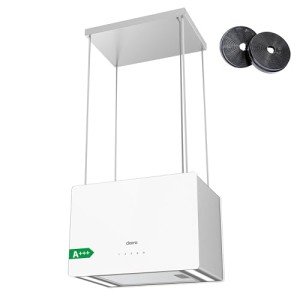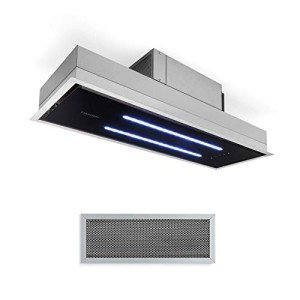How To Choose The Right Island Extractor Hood On The Internet
페이지 정보

본문
Understanding Island Extractor Hoods: A Comprehensive Guide
In modern kitchen areas, the role of an extractor hood, particularly the black island extractor fan extractor hood, can not be overemphasized. These devices not just boost the visual appeals of a kitchen island extractor however likewise play a crucial role in preserving air quality. In this short article, we will explore what island extractors are, their benefits, types, setup factors to consider, maintenance suggestions, and answer some often asked concerns to help home cooks and property owners in making informed decisions.
What is an Island Extractor Hood?
An island hob extractor extractor hood, likewise called an island range hood, is a type of ventilation system that is suspended above a kitchen island cooktop, where cooking takes place. Unlike standard wall-mounted hoods, which are attached to walls, island hoods hang from the ceiling, supplying unobstructed views and making sure effective ventilation for all kinds of cooking activities.
Advantages of Island Extractor Hoods
Island extractor hoods offer a wide range of advantages:
- Enhanced Air Quality: They effectively get rid of smoke, steam, and cooking odors, promoting a healthier kitchen environment.
- Visual Appeal: Available in different designs and finishes, island hoods can function as a sensational centerpiece in open-concept cooking areas.
- Versatility: Many designs come with flexible ventilation alternatives, dealing with both ducted and ductless setups.
- Noise Reduction: Advanced technology in contemporary extractor hoods often lessens functional noise, allowing for a pleasant cooking experience.
- Lighting: Many island hoods are equipped with integrated lights that light up the cooking area, improving presence throughout meal preparation.
Kinds Of Island Extractor Hoods
When choosing an island extractor hood, you will experience several types. Here's a quick introduction:
| Type | Description |
|---|---|
| Ducted | Ventilation system that requires ductwork to transport air outside the house. |
| Ductless | Uses filters to clean up the air before recirculating it back into the kitchen; perfect for apartment or condos. |
| Convertible | Can operate as both ducted and ductless, offering flexibility based on the kitchen design. |
| Integrated | Constructed straight into cabinetry or lighting, offering a streamlined, unobtrusive design. |
| Wall-mounted | Although not traditional island hoods, some wall-mounted hoods can be set up in a manner that serves kitchen islands. |
Installation Considerations
When setting up an island extractor hood, there are a number of important elements to think about:
- Height: The hood must be set up at a height of 28 to 30 inches above the cooktop to efficiently catch smoke and smells.
- Ventilation: Ensure proper ducting is readily available if choosing a ducted model, specifically in homes with complex designs.
- Air flow Capacity: Choose a hood with adequate CFM (cubic feet per minute) ranking to fit the cooking device. As a rule of thumb, multiply the BTUs of your cooktop by 1.5 to figure out the needed CFM.
- Power Supply: Verify that electrical wiring satisfies the hood's functional requirements. Speak with a professional if modification is needed.
Upkeep Tips for Island Extractor Hoods
Correct upkeep guarantees the durability and performance of your island extractor hood. Follow these pointers:
- Regular Cleaning: island range hood Clean the exterior surface areas and the grease filters monthly. Most filters can be washed in warm, soapy water.
- Examine Light Fixtures: Inspect and change bulbs as needed to ensure the cooking area is well-lit.
- Examine for Duct Blockages: island range hood If utilizing a ducted system, regularly examine ducts for obstructions to make sure ideal air flow.
- Display Noise Levels: If your hood begins to make unusual noises, check for loose parts or debris within the system.
- Set Up Professional Maintenance: Consider having a professional inspect and service your hood annually to attend to any prospective issues.
Frequently asked questions
What is the perfect CFM for an island extractor hood?
The perfect CFM depends upon your cooktop's BTU. For the majority of home cooking, a series of 600 to 1200 CFM is suggested, depending upon the strength of your cooking habits.
Can I set up an island extractor hood myself?
While DIY setup is possible for those with experience, having a professional install your island hood is recommended to ensure ideal performance and safety.
Are ductless island extractor hoods efficient?
Ductless hoods can be efficient in getting rid of smoke and odors when geared up with top quality filters, but they may not be as efficient as ducted versions in aerating hot air.

How frequently should I replace the filters?
For ductless designs, it is recommended to change the filters every 6 months to a year, depending on usage. Constantly refer to the producer's guidelines for specifics.
Island extractor hoods raise both the functionality and visual appeal of contemporary kitchen areas. With various types, setup alternatives, and upkeep tips, house owners can discover the ideal service to fit their cooking requirements and design preferences. By purchasing a quality island extractor hood, one not only enhances their cooking environment however likewise promotes a much healthier home. As you navigate choices, remember to consider your kitchen design and cooking routines to select a hood that completely matches your culinary way of life.

- 이전글The Sage Advice On Robot Vacuum And Mop From The Age Of Five 25.05.21
- 다음글The 10 Scariest Things About ADHD Hyperactivity Symptoms In Adults 25.05.21
댓글목록
등록된 댓글이 없습니다.